Hawaiian flora is beautiful and diverse. A subtropical region, Hawaii has a year-round warm climate and soil heavy with volcanic ash – two elements that play a role in the healthy growing of a wide variety of flowers and plants. There are three categories of Hawaiian flora – endemic, native and introduced. Endemic refers to those flowers, plants and trees found only in Hawaii. These are the flowering and non-flowering plants and trees that were brought to Hawaii by natural means, such as wind, tides and birds. Native refers to those species occurring in the Hawaiian Islands, but found elsewhere in the world. The third category includes foreign or introduced plant species. These are plants brought to Hawaii by people.
- Bougainvillea
- Hawaiian Hibiscus
- Plumeria
- Hibiscus syriacus (Rose of Sharon)
- Hinahina
- Protea Flower
- Heliconia Flower
- Hawaiian Gardenia
- Blue Ginger
- Naupaka
- Kalapana anthurium
- Tillandsia
- Hawaiian volcano plant
- Hawaiian Orchid
- ʻōhiʻa lehua flower
- Hawaiian sunset vine
- Pikake
- Croton
- Hawaiian lily ( Chalice vine)
- Hawaiian Rose
- Crown imperial flower
- Hawaiian Evening Primrose
- Ginger lily
- Ixora
- Glory Bush
- Princess flower
Bougainvillea

Bougainvillea is one of the most spectacular and colourful groups of climbing plants, native to Hawaii, Florida and South America. It varies in size and colour and can be grown in pots in a bright conservatory or in the garden (but must be brought inside in winter in cooler climates). Bougainvillea glabra is semi-evergreen, vigorous and thorny species, its flowery bracts being slightly wavy and a variety of colours including white, pink, magenta and purple/lavender. Its small flowers (in the centre of the bracts) are white and its leaves are a moderately glossy mid to dark green.
White Kauai hibiscus
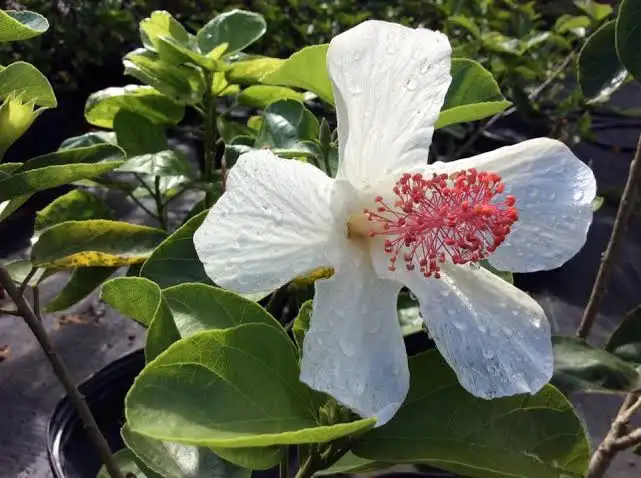
White Kauai hibiscus (Hibiscus waimeae), a shrub or tree, is native to Hawaii. It reaches 18 to 20 feet tall and 9 to 10 feet wide. It has large 5- to 8-inch flowers. The flowers bloom throughout most of the year, but each individual flower lasts only one day. Hibiscus brackenridgei, another evergreen hibiscus shrub native to Hawaii, likes warm tropical weather and reaches sizes of 8 to 15 feet tall and 4 to 7 1/2 feet wide. Hibiscus brackenridgei flowers are very showy, and they have a funnel shape with large stamens.
Plumeria
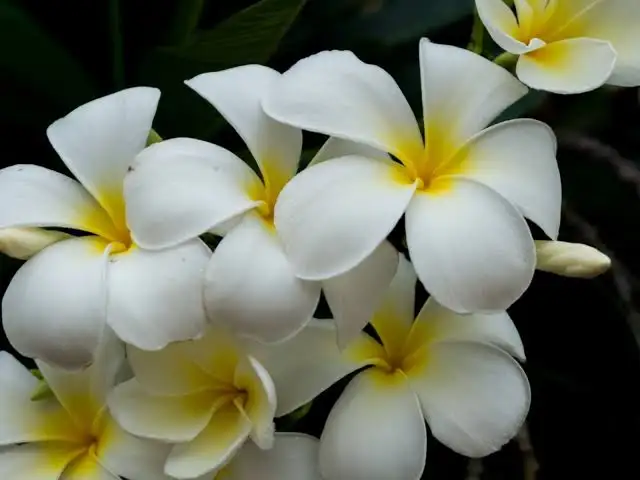
Plumeria, also known as frangipani, is an exotic tropical flowering tree with many varieties. Even with a range of colors and slightly differing flower styles, the various types share some characteristics that make plumeria uniquely identifiable, once you know what to look for. The name frangipani comes from the name of a 16th century Italian nobleman who created a perfume with a similar scent. Waxy, 2- to 4-inch tubular flowers are borne in terminal clusters on the ends of the stems from early summer until fall. The five rounded overlapping petals may be broadly to narrowly oval. Flower colors include pink, red, white, and yellow, or pastel bicolors.
Also Read: Mexican Flowers
Rose of Sharon
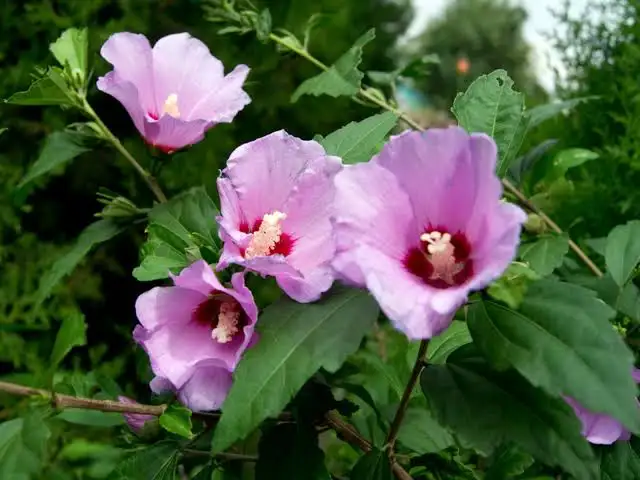
Rose of Sharon, also called shrub althaea, (Hibiscus syriacus, or Althaea syriaca), shrub or small tree, in the hibiscus, or mallow, family (Malvaceae), native to eastern Asia and Hawaii but widely planted as an ornamental for its showy flowers. It can attain a height of 3 metres (10 feet) and generally assumes a low-branching pyramidal growth habit. The mallowlike flowers range in the different varieties from white and pinkish lavender to purple, generally with a crimson base; certain varieties have double flowers.
Silversword

The Silversword is an exceptionally rare and endangered plant native only to the island of Maui and the Big Island of Hawaii. A very striking silvery-light-green color, this almost metallic looking plant consists of very dense rosettes of yucca type leaves that radiate out from a base. The leaves are thick and taper to a point at the ends. These rosettes can range in size from a few inches for babies to three or four feet for mature healthy adults.
However, what is really strange about Silversword is how it flowers. Silversword will live for 40 to 50 years before flowering once and only once. When it is time to flower the leaves seem to invert and bend upwards and out of the center rises a huge 4 to 6 foot stalk from which radiates hundreds of drooping yellow flowers. The entire result is something that resembles a narrow 6-foot tall mushroom – a very impressive sight.
Protea

Protea genus includes more than 1,000 species. These evergreens can grow low as shrubs or tall as trees depending on the variety. Goblet-shaped flowers bloom in large clusters with fluffy centers surrounded by bracts that are bright and spiky. Proteas were named after the Greek god Proteus, son of Poseidon, who had the ability to transform himself into many different shapes. These plants are known for their unusual and beautiful flowers, which seem rather mythological themselves, like blooms from an alien landscape—some can reach 12 inches across. Proteas are considered to be among the oldest of flowering plants.
Heliconia lobster claw

Heliconia lobster claw is also called parrot flower and has inconsequential tiny flowers covered by the showy bracts. Leaves are glossy, green, oval, and paddle shaped. They grow in an upright habit with the flower stems in the center. Flower bracts are arranged in terminal racemes, which may be held erect or pendulant. Heliconia lobster claw may be found in red, orange, or yellow, usually tipped with a bright gold splash. Flowers do not appear until this perennial is two years old.
Hawaiian Gardenia
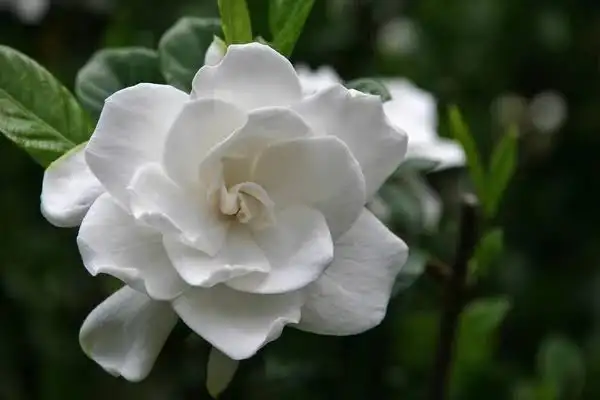
Gardenia brighamii, also called as Nanu, Forest gardenia, Hawaiian gardenia, is a species of the genus Gardenia. Gardenia brighamii is endemic to Hawaii. It is extremely rare and near to extinction throughout its native habitat. It is a shrub or small tree which reaching up to 15 feet in the wild, but is generally not as tall in cultivation. The leaves are glossy green, 1 to 4 inches long and about half as wide. Young leaves often feel sticky. When not under cultivation, the plants have leaves only on the ends of the branches.
The solitary white flowers occur at the ends of the branches. The flowers are tubular with 6 or 7 lobes, up to 1 inch long and have a fragrance similar to the Gardenia augustus. The flowers open in the late afternoon and last about a day. Following flowering, dark green fruits in the productive plants will eventually reach about the size of a golf ball or smaller. The fruits will remain green for several months.
Blue Ginger
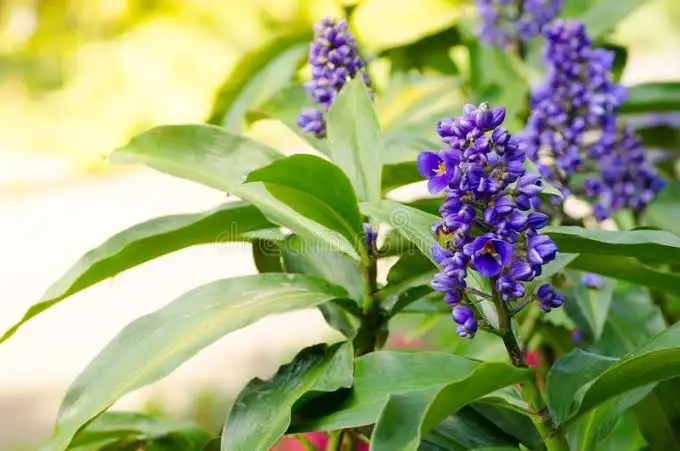
Blue ginger gets its name from its resemblance to ginger plants. It isn’t a true ginger. Blue gingers belong to the same family as inch plants and spiderworts. All are very easy to grow indoors. Blue ginger (Dichorisandra thyrsiflora) is a huge plant with big spikes of blue flowers atop a tall tower of foliage. Fortunately, there is also a pretty little version of this plant, the weeping blue ginger (Dichorisandra pendula). They make neat garden plants in tropical areas or gorgeous houseplants for those of us that experience cold winters. Both of these plants are easy to grow and tolerant of the conditions inside most homes. Blue ginger produces flowers that can last for months, and they continue to produce new flowers year round. The plants can be quite expensive, but propagating blue ginger is easy.
Naupaka
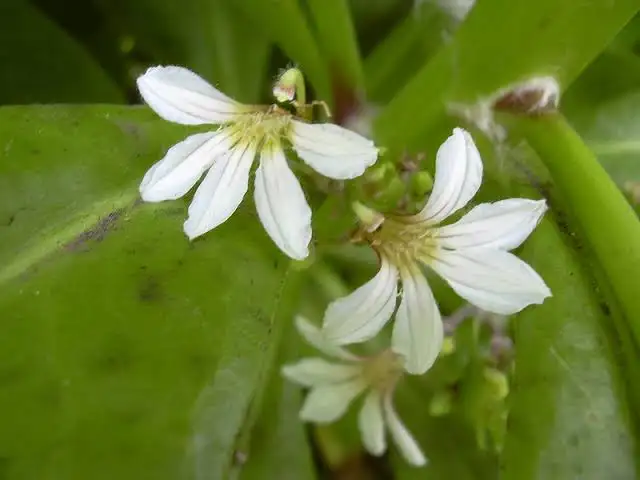
Common names for Scaevola species include scaevolas, fan-flowers, half-flowers, and naupaka, the plants’ Hawaiian name. The flowers are shaped as if they have been cut in half. Consequently, the generic name means “left-handed” in Latin. Many Hawaiian legends have been told to explain the formation of the shape of the flowers. In one version a woman tears the flower in half after a quarrel with her lover. The gods, angered, turn all naupaka flowers into half flowers and the two lovers remained separated while the man is destined to search in vain for another whole flower.
Naupaka has succulent green leaves, dark purple fruit, and cream-colored flowers where the tips of the petals cluster together on one side, appearing as though the other half of the petal tips are missing. It typically occurs in hot, dry coastal sites on low, consolidated sand dunes. Naupaka is endemic to Hawaiʻi, meaning it is found nowhere else in the world.
Also Read: Different Types of Florida Flowers
Kalapana anthurium
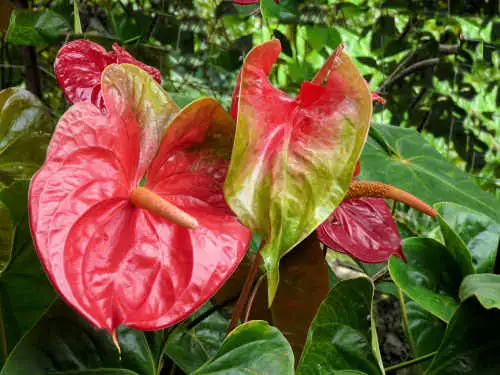
The unique red anthurium with green accented “ears” is known by the name of Kalapana. This cultivar was created by the University of Hawaii College of Tropical Agriculture in the early 1980’s to celebrate a unique fishing village on the southeastern shore of the Big Island of Hawaii. Its significance was enhanced when the Kilauea Volcano erupted in 1984 and a series of lava flows destroyed this formerly thriving seaside community in 1990.
Hawaiian Orchid

Orchids are an amazing family of plants all belonging to the Orchidaceae family which is recognized as the most diverse plant family in the world. Hawaii is often associated with brightly colored orchids. But most are commonly cultivated commercial varieties strung into lei, sold in nurseries and used for decoration and landscaping. In fact, Hawaii has only three native orchids: Hawaii jewel-orchid, Hawai’i widelip orchid and Hawaii bog orchid. All three species grow in the highest reaches of the islands’ forests and bogs, but it is the Platanthera, also called the fringed orchid, that is the rarest of them all. Gorgeous blooms feature unique color combinations like russet and yellow, and exotic shapes that will capture your imagination. Best of all, elegant Hawaiian orchids are low-maintenance, making it as easy to care for them as it is to enjoy them.
‘Ohi’a lehua
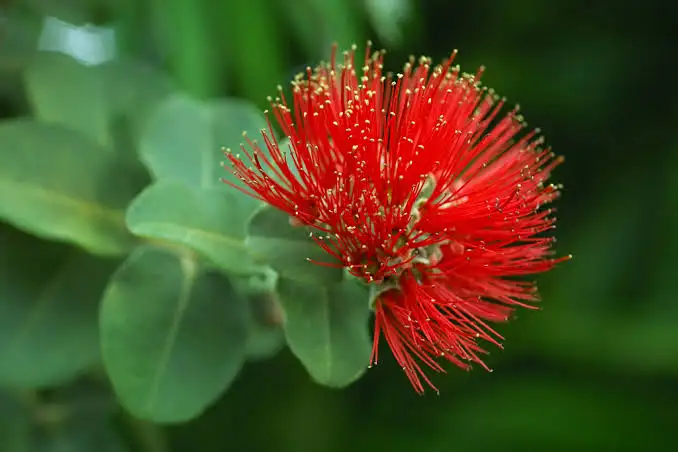
Metrosideros polymorpha (‘Ohi’a lehua) is an extremely variable plant. It ranges in habit from a prostrate shrub to a 100 foot tree. Young bark is smooth and light gray and becomes rough and scaly with age. In the landscape or garden, ‘Ohi’a lehua is generally no larger than 40 feet tall and 30 feet wide often with a broad, columnar silhouette. The leaves are generally oval in shape ranging in size from 1/2 to 3 inches long and 1/2 to 2 1/4 inches wide. The mature leaves are generally leathery and smooth dark green, but some forms are woolly or hairy underneath and may appear grayish. The leaf buds (liko) can range in color from pale green to pink to red. ‘Ohi’a lehua blooms mostly in the spring, but can bloom sporadically throughout the year.
Hawaiian Sunset Vine

Hawaiian Bell, Sunset or Braveheart Vine is a vigorous growing tropical vine that can easily cover a fence or trellis is a matter of weeks. It blooms several times each year in clusters of large, 2 to 3 inch bell shaped, nectar rich, flowers in the rich vibrant tones of coral, pink, mauve, and yellow of a tropical sunset. Blooms best in full sun, but will also flower in heavy shade. Leaves can grow to be as much as a foot across in the deep shade, so lends a luxurious, exotic feel to the subtropical landscape.
Pikake
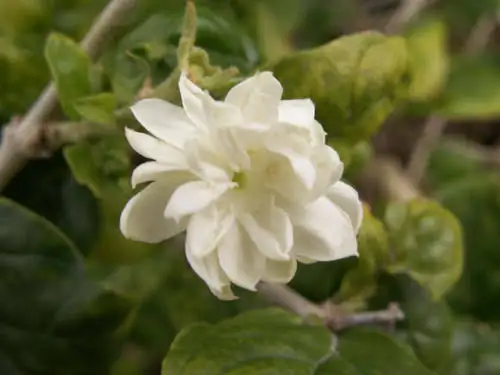
Pikake is the Hawaiian name for a Jasmin, Jasminum sambac, which is one of about a dozen of Jasmine species grown in Hawaii as ornamentals. It is a fragrant-flowered shrub, 2-3 feet wide and up to 6 feet tall, that is fairly hardy and drought resistant. It has a moderate growth rate in spring and summer but grows slowly during cool seasons. It has downy branches bearing rich green, rounded to oval, paired leaves with prominent veins. The plant has both bushy and viny growth characteristics. The cream-white flowers are borne at branch terminals either singly or in clusters on new growth. The unopened bud is oval and open flower is star-shaped.
Croton plants

Croton plants are known for being robust, dependable shrubbery. The leaves of this plant have a variety of colors, such as orange, red, purple and yellow with spotted and streaked patterns. The green-leaf croton is native to Fiji and other islands west of Australia. In Hawaii, the colored-leaf varieties are the most commonly seen yard plants. They can grow up to 12 feet (3.7 m) tall and are often trimmed as hedges.
Hawaiian lily
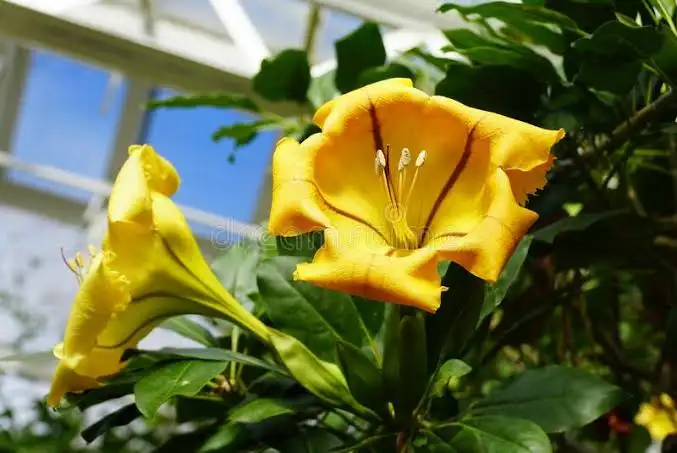
Also known as cup of gold vine, golden chalice vine, or Hawaiian lily, is a vigorous vine which is endemic to Mexico, Hawaii and Central America. It has very large yellow flowers and glossy leaves.A very unusual and easily grown specimen plant that is quite tolerant of seaside conditions. An excellent choice for large trellises and arbors or as an espalier.
Also Read: Different Types of Florida Palm Trees
Hawaiian Rose
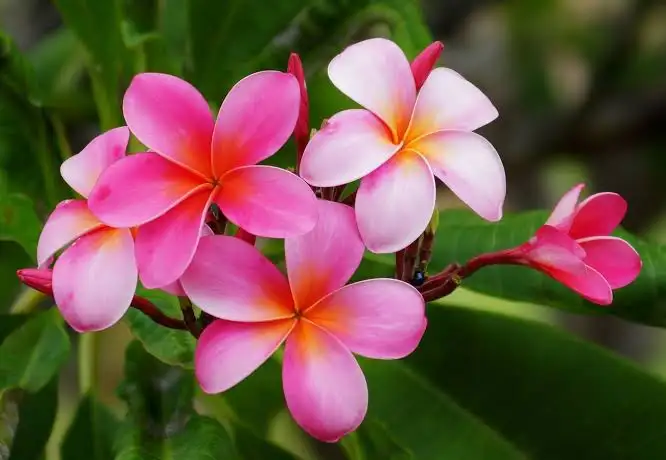
Hawaiian Rose (Argyreia nervosa; Hawaiian Baby Woodrose) is a perennial vine with large heart-shaped leaves and funnel-shaped flowers. Its heart-shaped leaves can grow to 1 foot in length, and the vine may clamber to 30 feet. Its lavender-pink trumpet-shaped flowers are of more moderate dimensions, however, usually about 2 inches across and 3 inches long with maroon centers. When open, the woody seedpods look like miniature roses, explaining the plant’s common name. Although similar to morning glory in culture, Hawaiian baby woodrose forms tubers that make it perennial in Hawaii.
Crown Imperial Flowers

Crown imperial flowers grows to about 3 ft in height, and bears lance-shaped, glossy leaves at intervals along the stem. It bears a prominent whorl of downward facing flowers at the top of the stem, topped by a ‘crown’ of small leaves, hence the name. While the wild form is usually orange-red, various colours are found in cultivation, ranging from nearly a true scarlet through oranges to yellow. The pendulous flowers make a bold statement in the late spring garden; in the northern hemisphere, flowering takes place in late spring, accompanied by a distinctly foxy odour that repels mice, moles and other small animals.
Evening primrose
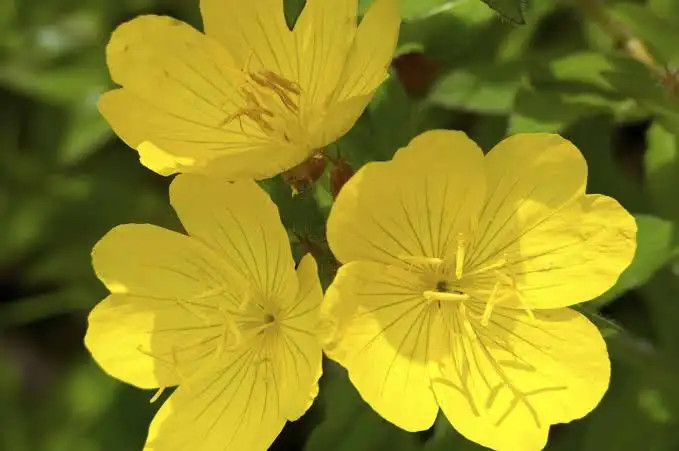
Evening primrose has a sprawling growth pattern, green leaves and small- to medium-sized flowers. The flowers bloom during late spring and summer. Hawaiian also referred to as Mexican evening primrose has pink or purple flowers, as does showy evening primrose. Common evening primrose and evening primrose wildflowers native to the Ozarks tend to be larger and yellow. The plant often stays low to the ground, reaching heights of between 6 and 24 inches tall. The plant foliage dies back during cold weather, making it less attractive during fall and winter than during summer.
Ginger lily

Ginger lily flowers perch atop tall stalks that emerge from a slow-growing rhizome. The stalks themselves are very fast growing, however, and they can easily reach 5 feet or taller by midsummer, with a spread of up to 5 feet. Its deep green leaves are lance-shaped and pointed and grow from 8 to 24 feet long and 3 to 5 inches wide.
The flowers are most abundant in midsummer to autumn, featuring 6- to 12-inch-long clusters of highly fragrant blooms, which are often used to make perfume. The name “butterfly ginger” is a reference to the petals’ resemblance to an intricately shaped butterfly.
Ixora
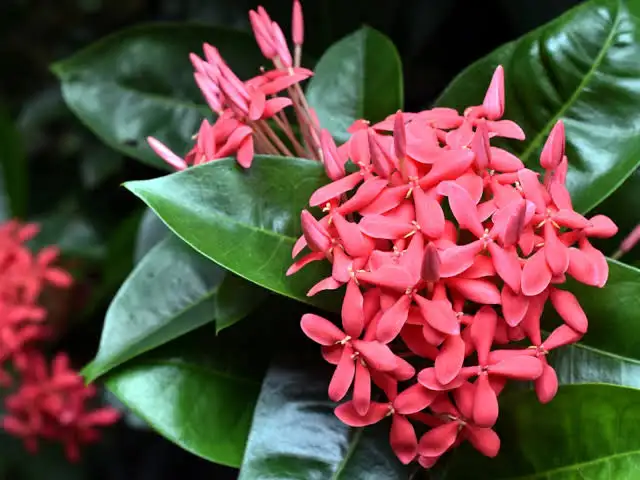
Although Ixora is a genus comprised of more than 400 species, Ixora coccinea — also known as ixora, flame of the woods or jungle flame — is the type most commonly grown in the home landscape. A rounded, evergreen shrub that reaches heights of 4 to 6 feet or more, ixora displays shiny, leathery leaves and masses of blooms that appear throughout most of the year. Depending on the variety, ixora is available in shades of red, yellow, orange or pink.
Glory Bush
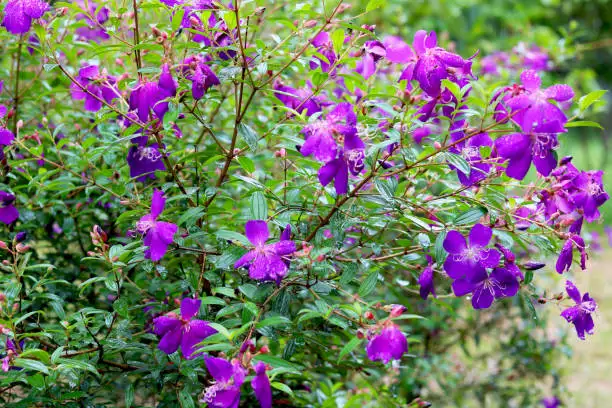
Glory Bushes are grown for their attractive foliage and flowers, some species flowering in spring and autumn and others all through summer. Foliage may be textured and has prominent venation. Flowers are bright and saucer-shaped, in a range of colours including pink, purple, blue and white, often with contrasting, showy stamens in the centre.
Princess Flower
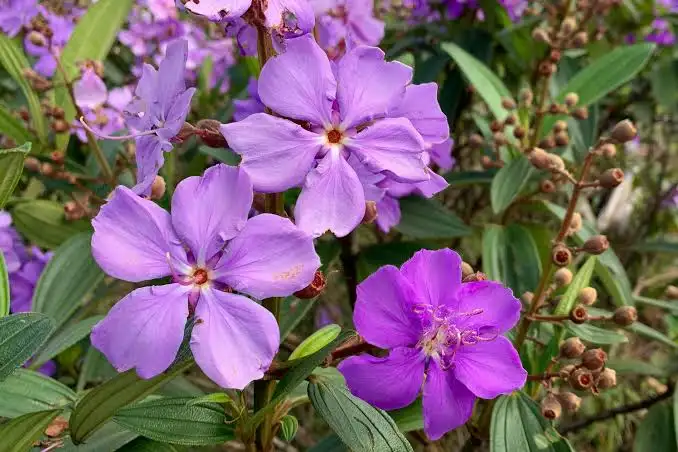
Princess Flower is an evergreen tropical shrub native to Brazil and Hawaii that is best used as an annual or house plant. This shrub can be trained into tree form and typically reaches 6-8 feet but can grow to 10-20 feet in warm winter areas. The showy purple flowers appear in terminal panicles and the tree has a long bloom season. The evergreen leaves are dark green with lighter undersides and are 4-6 inches long.